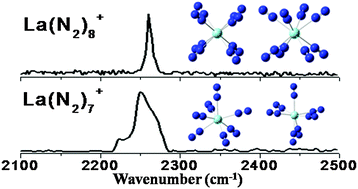Infrared photodissociation spectroscopy of M(N2)n+ (M = Y, La, Ce; n = 7–8) in the gas phase†
Abstract
M(N2)n+ (M = Y, La, Ce; n = 7–8) complexes have been studied by infrared photodissociation (IRPD) spectroscopy and density functional theory (DFT) calculations. The experimental results indicate that the N–N stretching vibrational frequencies are red-shifted from the gas-phase N2 value. The π back-donation is found to be a main contributor in these systems. IRPD spectra and DFT calculations reveal the coexistence of two isomers in the seven-coordinate M(N2)7+ and eight-coordinate M(N2)8+ complexes, respectively. The present studies on these metal–nitrogen complexes shed light on the interactions and coordinations toward N2 with transition and lanthanide metals.


 Please wait while we load your content...
Please wait while we load your content...